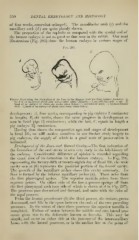Page 540 - My FlipBook
P. 540
550 DENTAL EMBRYOLOGY AND HISTOLOGY
of four weeks, somewhat enlarged). The mandibular arch (c) and the
maxillary arch (d) are quite plainly shown.
The proportion of the cephalic as compared with the caudal end of
the human embryo is not as great as that seen in the rabbit. Our next
illustrations (Fig. 295) show the human embryo in various stages of
Fig. 295.
Figures illustrating the Formation of the Face in the Human Embryo (from (IwtdWs Anatomy) : A,
he: d of ;m embryo of about four -neeks (after Allen Thomson) ; 1, mandibular arch; a, ear. B^
head of an embryo of about six weeks (after Kcker): 1, mandibular arch; 1', hyomaudibular
cleft. C, head of an embryo of about nine weeks (after Ecker}.
development: ..I, four ^\•eeks, corresponding to pig embryo 1 centimeter
in length; B, six weeks, shows the same progress in development aft
seen in foetal pigs 1^ centimeters; while the last, C, equals in length a
pig embryo 2^ centimeters.
Having tlms shown the comparative ages and stages of development
in foetal life, we will confine ourselves in our further study largely to
pig embryos, the supply of which in a good state of preservation is
unlimited.
Development of the Jaws and Buccal Cavity.—The first indication of
the formation of the oral cavity is seen very early in the life-history of
the embryo. Considerable difference of opinion is recorded regarding
the exact time of its formation in the human embryo. In Fig. 296,
representing the twenty-fifth or twenty-eighth day of foetal life, the wide
cavity seen at (6) represents the })osterior portion of the buccal cavity.
The growth of the maxillary arches closes this cavity anteriorly. Its-
These arise from
floor is formed by the inferior maxillary arches (4).
the first pharyngeal arches. The superior maxilla arises from three
separate points. On either side of the face a ]>rocess springs off from
the first jiharyngeal arch (one side of which is shown at d in Fig. 297).
Tlu! processes pass downward and Ibi'ward, and unite with the sides of
the nasal' ]irocess.
From the frontal prominence (1) the third process, the incisive, grows^
downward, and fills in the space between the ends of the two preceding
processes. By the union of these three proces,^es the superior maxilla is
completed. Failure of union between the middle and two lateral pro-
cesses gives ri.se to the (lefi)rmity known as hare-lip. This may be
simple, and occur on either side at the juncture of the intermaxillary
bones with the lateral processes, or in the median line at the point of


